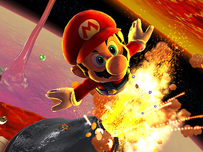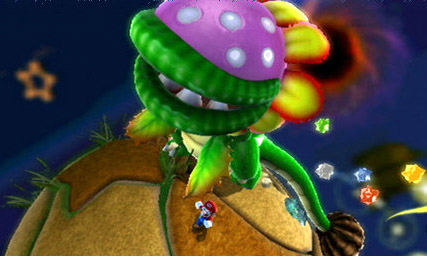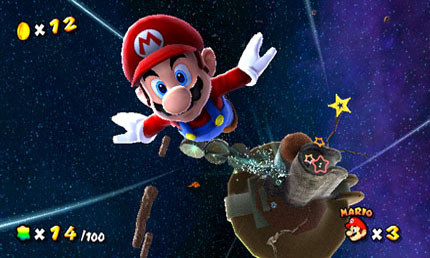
FEATURE: Galaxy Quest
Date: Saturday, October 06 @ 08:35:31 UTC
Topic: Off Topic
Mario is going boldly where no platformer has before, but can the most anticipated Wii title possibly meet the stratospheric expectations?
 He’s gaming’s most ubiquitous character, but what is Mario? At the very least, he’s a few red and blue pixels jumping around your television screen; at most, he’s a global icon better known than Mickey Mouse who, more than any other character, is synonymous with the term ‘videogame’. But whether jumping over barrels, sprinting to fill up a P-meter or simply soaring into the sky, one thing defines all of those videogames: getting from A to B. What Mario is the embodiment of for players, and the reason he’s so compelling to control, is a set of universal laws: mass, momentum and inertia. Mario means perpetual motion.
He’s gaming’s most ubiquitous character, but what is Mario? At the very least, he’s a few red and blue pixels jumping around your television screen; at most, he’s a global icon better known than Mickey Mouse who, more than any other character, is synonymous with the term ‘videogame’. But whether jumping over barrels, sprinting to fill up a P-meter or simply soaring into the sky, one thing defines all of those videogames: getting from A to B. What Mario is the embodiment of for players, and the reason he’s so compelling to control, is a set of universal laws: mass, momentum and inertia. Mario means perpetual motion.
In a wider context, the platform genre could just as easily be called the Mario genre, so fully have those games created and nurtured the tropes through which the style has evolved. Super Mario Bros 3 and Super Mario World reached a pinnacle of 2D game design; with Super Mario 64, Nintendo redefined what the move to 3D could mean and set an example that no subsequent game has lived up to. It was at once the ultimate expression of creativity and an achievement that hamstrung its many imitators – stories abound of N64 titles being abandoned halfway through development after Mario’s 3D debut. After all, what else could a 3D platformer do that that game didn’t? Is there anything left to add to that intoxicating mix? It’s taken Shigeru Miyamoto and Nintendo over a decade and several false starts to come up with an answer, and it’s numbingly simple: gravity.
With the internal logic of videogames being so recherché, the concept is less of a real-world limitation than a license for virtual extravagance – across the widest canvas that could be imagined. We’ve found every hidden corner of Super Mario World: it’s time to explore Super Mario Galaxy.
But to begin at home, what’s changed about Mario? It’s testament to the brilliance of Miyamoto’s original vision that he’s almost no different from his 3D debut over a decade ago, down to the smallest details: just like Super Mario 64, leave Mario alone long enough and he falls asleep. He’s completely familiar and – barring the graphical sheen – no different physically, bar a few new moves, and there’s even a return for an old one: the long jump. And those new moves are designed for convenience rather than revolution: it proves occasionally difficult in certain positions to line up a perfect jump on enemies, thus the spin attack removes the need to do so. If there’s any difference, Mario’s momentum can initially seem slightly muted from the slip-slide speed of Super Mario Sunshine, but that’s both a consequence of a slightly more panoramic camera and something well judged with relation to the gravity and locations. It’s a perfect example of a core strength of the Mario series, and Nintendo as a whole: building an entirely new structure around a familiar and solid foundation that clearly works.
So Mario’s the same plumber in a new world. The speed, and the slipperiness in a sense, comes from the new tricks of this environment: the first planetoid has a central hollow ‘core’ that will instantly transport Mario from top to bottom and back again, as well as several pipes that transport him from location to location on the surface. You can move from one side of a planet to the other in seconds. As well as these set elements, the gravity that controls movement on the planets has some remarkable applications: the one that delights initially, and is then repeated ad infinitum, is long-jumping from a surface and looping around the entire object. Naturally this can only be accomplished on the smaller masses – as Mario’s speed increases on each loop you get closer to the ground and desperately try to keep him going. It’s thrilling, and always slightly disappointing when you land.
The camera could have been a worry, but it’s robust and effortlessly follows these moves and your topsy-turvy running over and around the planets, changing the perspective during movement only rarely. As Mario launches from stars – which feels pleasingly fast – it follows his glide easily while giving you an overview of your imminent destination. Most effectively, the angle will sometimes change for a particularly dramatic turn as you slingshot around a black hole. Nor are these regular space flights simply passive breaks from the planets: though you can’t directly control Mario, you can collect stars by pointing at them with the Remote, while pointer secrets abound in the vast space that surrounds you.
This is the real revolution in the player’s relationship to Mario, and it’s a quiet one. The use of the pointer looks simple, and may seem from mere screenshots like Nintendo shoehorning Wii Remote functionality into a flagship title. But the basic pointer control is a subtle addition to 3D platforming that alters the dynamic of your play considerably once mastered. You can use the pointer to collect stars by moving it over them, to fire those stars at enemies or items on the screen by using the ‘B’ button, or for several other contextual interactions. The Remote can also be used to pull certain objects in the game – structures will sometimes act as slingshots, where you essentially have to twang the elastic back and launch Mario into space. It can also play with and bend elements of the levels, be used to move up vines in a spinning motion, or rotate the stems of seed parachutes to maintain momentum, and its use throughout is hugely tactile. You’ll find yourself spinning through crystals to release collectables and simply sprinting onwards, using the pointer to suck up the goodies, or firing stars at enemies in advance so Mario can dash through and send them flying. It gives a feeling of control over events onscreen that allows you to almost prefigure Mario’s movement through the level, and it’s a much more powerful collecting tool and influence on your play than it might seem.
Galaxy isn’t slow to emphasize this, but it does it in a subtle manner that’s also the first time any game has dared to look Super Mario 64 straight in the eye. The first part of the latter to be created, after Mario himself, was MIPS the rabbit – who found his way into the finished game’s basement and had to be caught for one of the castle’s secret stars. It was a piece of throwaway fun, yet rewarded you as much as any other individual effort in the game. The first part of Super Mario Galaxy has three MIPS-like rabbits which have to be chased around the surface of a planet: it’s at once an homage to the earlier game and an opportunity for Galaxy to show its changes. If you remember MIPS, you’ll remember he was difficult to catch, and it was only possible through using Mario’s dive – a move that has disappeared. So Galaxy gives you two options – you can spend time running down the rabbits until they tire, or if you’re familiar with your new abilities you can bounce stars off their heads to stun them for an easy catch. This time, your rabbit catching reward is a star of a different kind: one that will launch you into space. It’s a typically elegant piece of design, allowing the player to get a feel for the new surfaces, camera and abilities while fulfilling an entertaining, somewhat familiar, task.
After this, the game moves into gear. You launch into space, bounce on goombas and come across several small challenges that show off the game’s mind-bending surfaces. At the end of this first level – which is much larger and more involved than that of King Bob-omb, the first star in Super Mario 64 – you enter a chunky green pipe and have a final puzzle to solve involving switches, a wall-sticking environment, and solid rectangles that rotate and attempt to electrocute you. It’s utterly abstract, utterly compelling, and the whole experience, from blasting through your first star to smashing the huge goomba that guards the final pipe, is simply fun. Interestingly, this star is a ‘great’ star, and finding it results in a different animation from that of finding a ‘normal’ star, much as with the keys in Super Mario 64 – suggesting that the structure of Galaxy will be similar.
There will be six main themes to the 40 galaxies, each with multiple planets and environments and a total of 120 stars between them, and the design team have confirmed the usual range of themes, from a ghost house and snowy plains to a lava planet. The locales are instantly familiar, from Mario grasping a shell in the inevitable underwater planet to running around the ring of doughnut worlds, but Nintendo has many more uniquely styled areas up its sleeve that it will not be revealing before the game launches.
The galaxies have distinctive visual identities – the Star Dust galaxy, for example, has a purple tinge to distant constellations and the levels seem to be full of more geometric shapes formed into angular arrangements. There’s an almost building-brick quality behind many of the stages, with seemingly arbitrary connections, angles and segments shooting off in any direction necessary. The Honeybee galaxy, on the other hand, features as its backdrop a bright blue sky with puffy clouds, its foreground a jumble of rounded corners and vaulted archways. More interestingly, this is a flat stage, retaining several of Galaxy’s visual signatures as Mario moves through the level, such as the jump stars and a camera-twisting slide, but it’s not a 3D structure that can be navigated on every surface.
That aspect of the design can’t be overemphasized: Super Mario Galaxy isn’t simply about running around globes. The levels incorporate anything from asteroid nuggets to huge pill-shaped structures with walls made of glass, and they’re held together thematically rather than structurally. There are completely forgiving gravity-fests where leaps into space will simply lead to whirling around the various centers of gravity pulling Mario, and planets that are hollow shells of their former selves with a black hole at their core, where your platforming will have to be at its best. But whether playing on the flat levels or the hugely expansive heliocentric collections of space junk, they feel genuinely open, despite the obvious linearity of your objectives, and free-roaming around them is encouraged with the usual assortment of hidden tricks and locations. Captain Olimar’s ship even turns up a few times as a navigable part of the scenery, and several other Nintendo in-jokes appear throughout. The locations also feature constant movement, whether it’s simply creatures popping up to waddle around or asteroids smashing into the ground around you, with stars popping out and waiting to be swept up with the Remote.
In this range of environments and the playful approach to their construction, it’s obvious that Nintendo has picked up on the criticisms leveled at Sunshine’s relatively few environments and repetition. Sunshine also suffered from, among other things, the imposition of an unnecessary external narrative beyond ‘Princess captured, go rescue’ – it was the first Mario game to put him in anything approaching a realistic world, away from the pipes, mushrooms and question blocks that surrounded his adventures. But where the Piantas and Isle Delfino felt a little too contrived and even (whisper it) soulless, Super Mario Galaxy, though no less populous, feels more naturally Mario’s world. There are toads, talking bees and friendly stars waiting to speak to you in the earlier levels (communication is handled via an automatic and unobtrusive speech bubble which doesn’t stop the game), and where Sunshine’s population was full of complaining Piantas and demanding tasks to be fulfilled, Galaxy’s script looks to be classic Nintendo, at once practical, childish and self-referential. In the Honeybee galaxy, one of the worker bees tells you: “That red and blue outfit looks so tacky!” while another informs you that “The castle’s past this wall – bees never lie!”
Perhaps the biggest lesson learned, however, is what makes the Mario series unique. They have something that almost no other game, never mind platform game, can muster: nostalgia. And Galaxy exploits this wonderfully and mercilessly. Levels have been seen showing Monty Mole, bob-ombs, boos, Pokey (the four-segment cactus), thwomps, magikoopas, chain chomps, unagis, flippy birds, bloopers, dry bones, wigglers, piranha plants, koopa troopas, bullet bills and even pumpkin goombas. There are 1up mushrooms, power mushrooms and even question blocks (with the old hit-repeatedly-until-it’s-empty trademark). Mario has been shown jumping on airships reminiscent of the battlefields from World 8 of Mario Bros 3, and moving through pipe lands that twist in space in a brain-fizzingly angular manner. There are remarkable abstract sections, played out to a slightly updated form of the ‘pipe world’ music from the original Super Mario Bros, where squares, triangles and rectangles float in space, and as Mario runs into emptiness they coalesce into platforms under his feet. After initial trepidation, they prove to be as solid a surface as the planets, and inspire several flights of jumping fancy into nothingness. Even the most unfamiliar moments have elements that are designed to make the Nintendo fan in all of us rejoice.
What’s surprising is how familiar it is, and yet how utterly fresh it still feels. Every previous game in the series seems to have been considered as a possible source for new material. It views and uses one of the most venerable histories in gaming as only a truly confident title can, and is something you want to prod and poke and simply play with. No one yet knows if Galaxy can maintain the momentum and range of its early showings, and avoid the repetition that marred Sunshine. No one yet knows if it will be able to thrive on the unavoidable comparisons to one of gaming’s landmark titles. They’re unfair, in a sense, because nothing can ever match up to that moment when you set your eyes on Mario 64; nothing ever could compare to that change in dimension. But Super Mario Galaxy has something of its own. It’s the sense of a universe of possibilities with everything you can imagine, and more that you can’t. It’s a sheer joy. It’s the sense of something you thought may have been lost to videogames returning. The feeling of wonder might, just might, be coming back.
News-Source: http://www.next-gen.biz
|
|